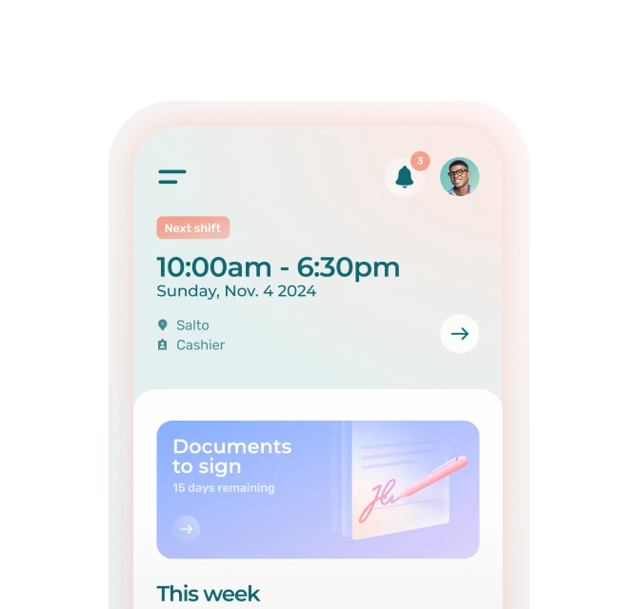Staff and absenteeism just seem to go hand in hand. Sooner or later, certain employees might make a habit of coming in late.
No business wants to normalize absenteeism, especially if it becomes too frequent or counterproductive, let alone unjustified.
Absenteeism at work is very costly. In fact, according to an American study, it costs companies more than $225 billion a year, an average of $1,685 per employee.
The repercussions of unplanned employee absences are not just financial. Absenteeism in a company also affects employee morale, hinders the work-life balance of staff members, has negative impacts on customer service, damages the company’s reputation, and so on. The impacts are felt by companies and their employees alike.
In order to have a productive business and offer a positive working environment, organizations need to double their efforts and tackle the problems caused by excessive absenteeism.
What Are the Causes of Employee Absenteeism?
The causes of absenteeism can be multiple, and vary enormously from one employee to another, or from one company to another.
The main cause of employee absence is physical health. An employee may be forced to take impromptu leave due to a virus such as the flu or a cold. Some companies may also notice that their organization’s absence rate increases at certain times of the year. For example, in January 2022, nearly 5.4% of American workers were absent from work due to illness. People are typically sicker during this month due to winter and holiday family gatherings.
Many employees also have to take time off work due to mental health issues that may or may not be work-related: burnout, depression, anxiety, workplace accidents, etc. Excessive stress or workloads can also be the cause of many physical and mental health problems.
Other causes of absenteeism include absences linked to a toxic work environment (harassment, discrimination, poor relations with colleagues, etc.). Some of your employees may also be experiencing hardships in their personal lives that will force them to take short- or long-term absences, such as the death of a family member or the need to care for a sick relative (children, parents, partner, etc.).
Finally, employees with low motivation and commitment to work will also tend to be absent more than their colleagues.
Tips for Reducing Absenteeism at Work
Here are our top 13 tips on how to reduce employee absenteeism. Get inspired by our tips and tricks to tackle the problem in your team.
1. Look for the Root Cause of the Problem
To better understand the issue, the first thing to do is to identify and assess the main cause. Does absenteeism seem to affect one particular employee or is it more of a widespread situation? Is absenteeism at its worst during a specific time period, for example in the evening or early in the morning? Is a certain department affected more deeply?
The idea here is to understand whether the root of the problem is the entire workplace or just one particular person.
2. Promote Open Communication
To get feedback from your team, you first need to foster an environment where communication is transparent. This will allow your employees to openly express their needs and desires. What’s more, it will allow you to accurately assess their overall satisfaction. Is your staff happy at work? Asking this question may very well help you find answers. Besides, your staff must also have a way of telling you about the challenges they face in their personal lives. Such challenges are a common cause of absenteeism. Just remember this: clear and transparent communication is key to avoiding misunderstandings!
3. Implement an HR Policy
Once you have fully understood the situation—and made sure your staff feels free to communicate with their managers—the time has come to put forth a human resources policy if you have not already done so. The purpose of such a policy is to reduce stress and demotivation, as well as to manage expectations. It should promote a positive, safe, and healthy work environment and lay out exactly how leaves work in your organization.
What Should an HR Policy Contain?
The following elements are core. Feel free to develop further, however; the more comprehensive, the better.
- Work hours: What is the typical work schedule like? Is it flexible? To what extent can you deviate from it?
- Overtime compensation: Can staff work overtime? If so, how are those hours compensated for?
- Annual leave: How many weeks are allowed, and when can employees take them? To whom can they talk to plan them?
- Public holidays: Which ones are paid?
- Sick leave and other time off: How many sick days are allowed per year?
- Performance assessment: At what intervals will staff be evaluated? How will it work? Will assessments take place during a meeting or involve written documents, charts, or objectives?
4. Include an Absence Management Policy
Your broader HR management policy should include a section on absence management. To hatch one, we suggest positing different scenarios. What happens if X? What if Y follows as a consequence? And so on. It is always better to plan for as many situations as possible, unlikely though they may be.
Of course, absences might sometimes be justified, hence the importance of defining efficient and uniform criteria to assess any given reason.
The clearer the expectations, the more gray areas will be avoided. Consider escalating sanctions depending on the number and gravity of offenses. For example, you might want to give a written warning the first time an employee shows up late without notice, a verbal warning the second time, and so on.
Distinguishing Reported Absences From No-Shows
You should ask yourself the right questions: will you treat reported absences the same as no-shows? A distinction should be made here: a “no-show” is when an employee fails to attend work without notice.
5. Implement Better Schedule Management
Use employee scheduling software to track your team’s work time more accurately and rigorously. With better schedule management, you can also offer your employees greater flexibility and avoid last-minute absences for personal reasons, for example.
Some tools also offer the possibility of allowing your employees to swap shifts. This makes them more responsible for their schedules, and avoids the need to find replacements at the last minute.
6. Know Your Area’s Policy on Time Off for Family and Health Reasons
With the aim to keep moving towards a better work-family balance, the CNESST recently spearheaded legislative amendments regarding leave for family and health reasons, amendments which only apply in Québec. As you might know already, since last year, the Act Respecting Labour Standards provides employees with ten unpaid days off for family-related reasons per year. Employers now have to pay two of those days, which may also be used for health reasons, although not cumulatively. Of course, as an employer, you have to observe these legislative amendments and include them in your HR management policy. Whether all time off must be substantiated, however, is for you to decide.
7. Monitor Staff Absences
Our final bit of advice is to keep track of staff absences in a detailed record. Some scheduling and attendance applications, such as Agendrix, allow for simple and straightforward monitoring. Such a tool will be your chief ally in identifying recurring absences in employees. It will also allow you to identify, understand, and eventually root out their causes.
8. Offer More Support to Your Employees
Nearly 40% of employee absences are for personal reasons. So make sure you offer support to your employees so they can juggle their personal and professional obligations more effectively.
For example, set up an employee assistance program and actively promote it within your team. And don’t hesitate to change your management methods to listen to your employees and reduce their stress levels.
Above all, offer flexible working schedules and even the possibility of teleworking to make things easier for your employees. They’ll certainly be more satisfied and motivated at work.
Improving the well-being of your team members should be an important objective if you really want to counter excessive absenteeism.
9. Demonstrate More Employee Appreciation for Your Team’s Work
If your employees don’t feel that their work is recognized, they will be much less committed and are likely to be absent more often. So, thank your employees for their work and highlight their achievements as often as possible.
We often underestimate the power of employee recognition. It’s a simple and effective strategy to implement in any workplace.
In fact, Agendrix employee management software even offers a module for sending high-fives to your employees. By using such a tool, you’ll build a strong culture of recognition in your team.
10. Reward Attendance
Don’t hesitate to reward your employees’ diligence. For example, you can offer an attendance bonus to employees who comply with your absenteeism policy.
A monetary reward can be particularly effective in ensuring that employees don’t drop out at the last minute. In fact, many companies with night-time schedules implement this practice.
11. Foster Employee Engagement
Make sure you communicate well with your employees, so that they feel included in the company’s decisions. The greater their commitment to the organization and their work team, the more they will want to give their best and reduce absences. Ask them for feedback, listen to their opinions and make yourself available.
Don’t hesitate to organize team-building activities to foster team cohesion and collaboration. This will have a direct impact on the quality of relations between your team members and will probably reduce the number of conflicts.
12. Offer More Paid Leave
Rested employees are less sick, less absent and more productive. So it really pays to offer your employees enough paid time off.
Don’t just comply with labor laws, offer more leave. You’ll quickly see the benefits in your business.
If you can, offer more sick days too. You could even offer personal leave days to give your employees more flexibility. This will certainly help you reduce employee absenteeism.
13. Conduct a Return-To-Work Interview
When your employees are absent for an extended period of time, it can be very useful to conduct a return-to-work interview. Not only will this clearly demonstrate that you care about them, but it will also enable you to validate a number of important pieces of information.
For example, you’ll be able to see if they’d like special support, or if there’s anything you could do to make their return easier. At the same time, you can offer them additional training to update their knowledge, or simply present them with important information that has changed since their absence.
Counter Employee Absenteeism Through Better Transparency and Organization!
To sum up, we have seen that the best way to minimize and control staff absenteeism is to make clear how things work in your organization. To clarify expectations, be it by implementing an HR and absence management policy or otherwise, is essential.
And don’t forget to increase employee commitment by recognizing their work and creating a healthy work environment.
Now you know all about how to reduce employee absenteeism, it’s up to you.
For more information on legislation relating to CNESST, here are two other useful sources:
What Are the Top Causes of Absenteeism?
The main causes of absenteeism from work include:
- Illness and injury
- Burnout
- Work-related stress
- Personal reasons
- The need to care for a family member
- Parental responsibilities
- Job search
- Lack of flexibility in work schedules
- Mental health problems
- Workplace harassment
- Lack of motivation or commitment
- Employee management problems
What Are the Effects of Absenteeism?
The negative effects of absenteeism in the workplace include:
- Increased overtime
- Decreased productivity
- Increased stress at work
- Increased operating costs
- Decreased quality of employee relations
- Decreased employee satisfaction
- Increased employee turnover
How Do You Deal With Absenteeism in the Workplace?
Solutions to better manage absenteeism at work include:
- Offering flexible schedules
- Rewarding employee attendance
- Allowing telecommuting
- Having an absenteeism policy
- Offer an employee assistance program
- Demonstrate empathy
- Reduce stress at work
- Have a time tracking tool
- Increase employee motivation and commitment
- Have a human resources management policy
- Improve communication within the organization
How Does Absenteeism Affect the Workplace?
Absenteeism directly affects the workplace by increasing employee workloads and team member stress levels. As a result, customer service can be greatly affected, and employee relations can deteriorate. A company’s productivity and efficiency can therefore be compromised.
How Many Absences Are Too Many at Work?
The average absenteeism rate for a company is around 1.5%, according to experts.
The formula for calculating a company’s absenteeism rate is as follows:
(Number of hours absent / Number of planned working hours) × 100
A company’s absenteeism rate can vary according to industry, economic context and time of year.













